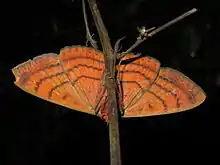Spirama retorta
Spirama retorta, the Indian owlet-moth, is a moth of the family Erebidae. The species was first described by Carl Alexander Clerck in 1764. It is found in China (Tibet, Qinghai, Jiangsu, Fukien, Yunnan), Korea, Japan (Honshu),[3] India (Sikkim, West Bengal), Nepal, Bangladesh, Thailand, Cambodia, Myanmar, Vietnam, Taiwan, Sri Lanka, Malaysia, the Philippines (Luzon), Indonesia (Java, Sulawesi),Japan (Ryukyu Islands).[4][5]
| Indian owlet-moth | |
|---|---|
 | |
 | |
| Scientific classification | |
| Kingdom: | Animalia |
| Phylum: | Arthropoda |
| Class: | Insecta |
| Order: | Lepidoptera |
| Superfamily: | Noctuoidea |
| Family: | Erebidae |
| Genus: | Spirama |
| Species: | S. retorta |
| Binomial name | |
| Spirama retorta | |
| Synonyms | |
| |
Description
The wingspan of the male is about 64–76 mm and 66-88 in female. The pattern on the wings often looks like the face of a snake with slightly opened mouth. Forewings with arched costa towards apex, which is nearly rectangular. Male with a fold on inner area of hindwing, containing an erectile ridge of very long hair. Antennae fasciculate. Male has dark chestnut-brown colored head and collar. Thorax paler with dark bands. Abdomen crimson with triangular black dorsal patches. Wings fuscous brown. Forewing with the costal and outer area more or less suffused with purplish and sometimes with an olive tinge. An antemedial line curved outwards below costa, and then oblique to inner margin. There is a large "inverted-comma" mark beyond end of cell, with ochreous and black edges and some white on inner edge of "tail", the center fuscous-black. A postmedial curved line passing round the stigma or interrupted by it. Another postmedial line excurved below costa and slightly sinuous. Two crenulate sub-marginal line and two more prominent lines can be found within the margin. Hindwings with indistinct antemedial, medial, and traces of two postmedial and a sub-marginal line. Ventral side is suffused with dull red and having two medial lines and single postmedial to each wing.[6]
Female basically ochreous colored. Forewings with larger stigma than male. Hindwings with prominent markings. Two antemedial lines and an ochreous submarginal line can be seen along with two crenulate black lines inside the margin. Ventral side orange-scarlet colored, each wing with cell-spot, medial, postmedial and submarginal lines and series of lunules inside the margin.
The caterpillars are known to feed on Acacia mangium, which was investigated from Peninsular Malaysia. Predators like Sycanus leucomesus, Cantheconidea furcellata, Mallada basalis, and Vespa affinis are observed to feed on the caterpillars.[7] Caterpillars also feed on Acacia auriculiformis, Acacia crassicarpa, and Falcataria moluccana.[8]
_(7857709798).jpg.webp) Dark form
Dark form Common pale form
Common pale form
References
- Savela, Markku. "Spirama retorta (Clerck, 1764)". Lepidoptera and Some Other Life Forms. Retrieved January 22, 2019.
- Yu, Dicky Sick Ki. "Spirama retorta (Clerck 1759)". Home of Ichneumonoidea. Taxapad. Archived from the original on January 23, 2019. Retrieved January 22, 2019.
- "オスグロトモエ Spirama retorta (Clerck, 1759)". Digital Moths of Japan. Retrieved 17 August 2016.
- Naturkundliches Informationssystem
- "Spirama retorta Clerck, 1764". India Biodiversity Portal. Retrieved 17 August 2016.
- Hampson, G. F. (1894). The Fauna of British India, Including Ceylon and Burma: Moths Volume II. Taylor and Francis – via Biodiversity Heritage Library.
- Sajap, Ahmad Said; Wahab, Yaacob Abd; Marsidi, Aidah (1997). "Biology of Spirama retorta (Lepidoptera: Noctuidae), a New Pest of Acacia mangium in Peninsular Malaysia". Journal of Tropical Forest Science. 10 (2): 167–175. JSTOR 43582114.
- "Effects of Food Plants on Development of Spirama retorta" (PDF). Pertanika Journal of Tropical Agricultural Science. 23 (2): 97–101. 2000.
| Wikispecies has information related to Spirama retorta. |
| Wikimedia Commons has media related to Spirama retorta. |
External links
- Effect of ivermectin on larval mortality and reproductive potential of Albizia foliage feeder, Spirama retorta Cramer (Lepidoptera: Noctuidae)
- Spinosad toxicity induced larval mortality in Albizia foliage feeder, Spirama retorta Cramer
- Growth performance of foliage feeder, Spirama retorta